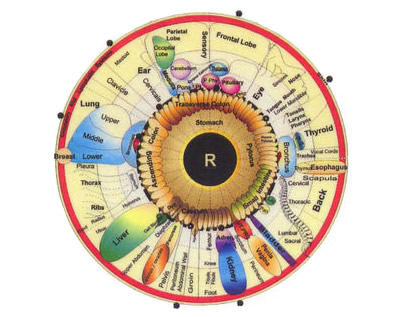What Is Iridology?
Iridology is the scientific analysis of patterns and structures in the iris of the eye which locates areas and stages of inflammation throughout the body. The iris is the portion of the eye showing color. It reveals body constitution, inherent strengths and weaknesses, health levels, and transitions that take place in a person's body according to their way of life.
HOW DOES IT WORK?

WHAT WILL IT SHOW?
A complete iris analysis will show whether a person exhibits a generally good constitution or a poor one, depending upon the density of the iris fibers, the patterns, structures, colors and degrees of lightness and darkness in the iris tell if an area of the body is inherently strong or weak. It also reveals the relative site of over-activity, irritation, injury or degeneration of the tissues and organs. Toxic accumulation levels can be observed as well as nutritional and chemical imbalances.
WHAT WILL IT NOT SHOW?

HOW CAN IT HELP ME?
Iridology is potentially an integral part of preventive health care. It has the ability to forewarn of approaching difficulties or signs of "dis-ease". Iridology can be a powerful tool, allowing one to determine what is transpiring inside the body from a simple, painless, and economical external vantage point. In effect, iridology will reveal how well your body functions. Improper nutrition and lack of exercise undermines the body's integrity until eventually it becomes unable to reverse damaging toxic conditions through its own natural self-healing mechanisms, becoming susceptible to ailments of a chronic nature. Therefore, nutrition and iridology are inseparable in one's pursuit of a healthy way of life and holistic health care program. Iridology helps us understand our weakness so we may strengthen and cleanse our bodies to obtain our maximum health potential. It brings to us an awareness of how to prevent illness, thus allowing us to earn our most precious earthly treasure--vibrant physical, mental and spiritual health!
American doctors usually can't tell you the score until the game's over--until you actually have a namable disease, but iridology lets you walk in at the first inning and that's why it will probably play a staffing role in preventative medicine at the bioelectric level, which is well on its way to becoming the medicine of the future.
HISTORY

Hippocrates
Descriptions of iridological principles (without using the word iridology) are found in Chiromatica Medica, a famous work published in 1665 and reprinted in 1670 and 1691 by Philippus Meyeus (Philip Meyen von Coburg).

Ignatz Peczely
Ignatz von Peczely qualified in medicine at the Vienna Medical College in 1867. He continued to study the irises of patients before and after surgery, systematically recording, correlating what he observed. He published his research in the book 'Discoveries in the Realms of Nature and Art of Healing'. His 'Iris Chart' was established in 1880.

IRIS Chart
Since these early days in the history of Iridology there have been many noted pioneers in this fascinating field. The German contribution in the field of natural healing is due to a minister Pastor Felke, who developed a form of homeopathy for treating specific illnesses and described new iris signs in the early 1900s. The Felke Institute in Gerlingen, Germany was established as a leading center of iridological research and training. Another German, Joseph Deck (1914-1990) founded the famed iridology research institute in Ettlingen, Germany.
An American medical doctor Henry Lahn (circa early 20th Century), his student Dr Henry Lindlahr (circa early 20th Century) who was both a medical doctor and osteopath and more recently, Dr. Bernard Jensen (1908-2002), the acclaimed naturopathic practitioner who established the modern, American school of iridology further developed the science of Iridology. Jensen insisted on the importance of the relationship between Iris signs and the body's exposure to toxins, and the use of natural foods as detoxifiers to remove them.




